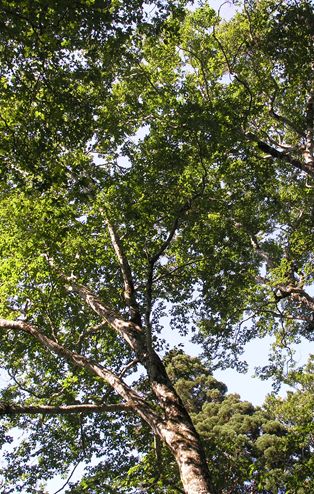研究成果 Research Results
- TOP
- News
- Research Results
- Beech tree growth recovered as air pollution levels fell
Beech tree growth recovered as air pollution levels fell
Reduction in inflow of air pollution from China found to be associated with changes in tree growth on Mt. Tateyama 2020.09.30Research ResultsEnvironment & Sustainability
Recently published research performed in collaboration with Kyushu University indicates that reductions in air pollution from the Asian continent reaching Japan may be leading to a rebound in the growth of beech trees in the central mountainous area of the island nation.
Sharp increases in the consumption of fossil fuels in the early 21st century—particularly in China and Korea—combined with long-range transport processes capable of carrying pollutants from East Asia to Japan resulted in increases in ozone and acid deposition, bringing with them associated harmful effects.
However, ozone concentrations around Japan have been decreasing since 2008 in part to both reduced emission driven by China’s implementation of air pollution countermeasures and reduced transport attributed to La Niña-like climatic patterns from 2008 to 2013.

Temporal change in atmospheric ozone concentration at Mt. Happo. Since 2008, the concentration has dropped sharply.
Analyzing long-term monitoring data obtained at Mt. Tateyama in Toyama Prefecture from forests facing the Asian continent, researchers now have a better understanding of the effects that these changes in air pollution are having on Japan’s forests.
The researchers found that the girth growth rate of beech trees has increased since 2008, coinciding with decreases in air pollution, while the growth rates of Japanese cedar—a conifer resistant to air pollution—have remain unchanged or decreased. Furthermore, no such trend was seen in an area that is better protected from air pollution by surrounding mountains.

Annual diameter at breast height (DBH) increase per trunk over two periods. Solid circles (●) indicate individuals with DBH greater than or equal to 40 cm; open circles (○) indicate individuals with DBH less than 40 cm.
These findings indicate that recent decreases in regional air pollution may be an important factor influencing increases in beech trees, likely through changes in interspecific relationships between species sensitive to and tolerant of air pollution.
"The effects of China's air pollution-abatement measures are being seen not only in various atmospheric observation data but also in our forests,” comments Atsushi Kume, professor of Kyushu University’s Faculty of Agriculture and first author on the study reporting the results. “To keep Japan's forests healthy, cooperating with Asian countries is critical.”
“Long-term forest monitoring is key for understanding the effects of the atmospheric environment and global warming on our forests and the balance among the species within them," he continues.
###
For more information about this research, see “Impact of reduced ozone concentration on the mountain forests of Mt. Tateyama, Japan,” Atsushi Kume, Mao Fujimoto, Nobuya Mizoue, Hideharu Honoki, Haruki Nakajima, and Megumi Ishida, Environmental Pollution (2020). https://doi.org/10.1016/j.envpol.2020.115407
Research-related inquiries
Atsushi Kume, Professor
Department of Agro-environmental Sciences, Faculty of Agriculture
Contact information can also be found in the full release.
- TOP
- News
- Research Results
- Beech tree growth recovered as air pollution levels fell
































